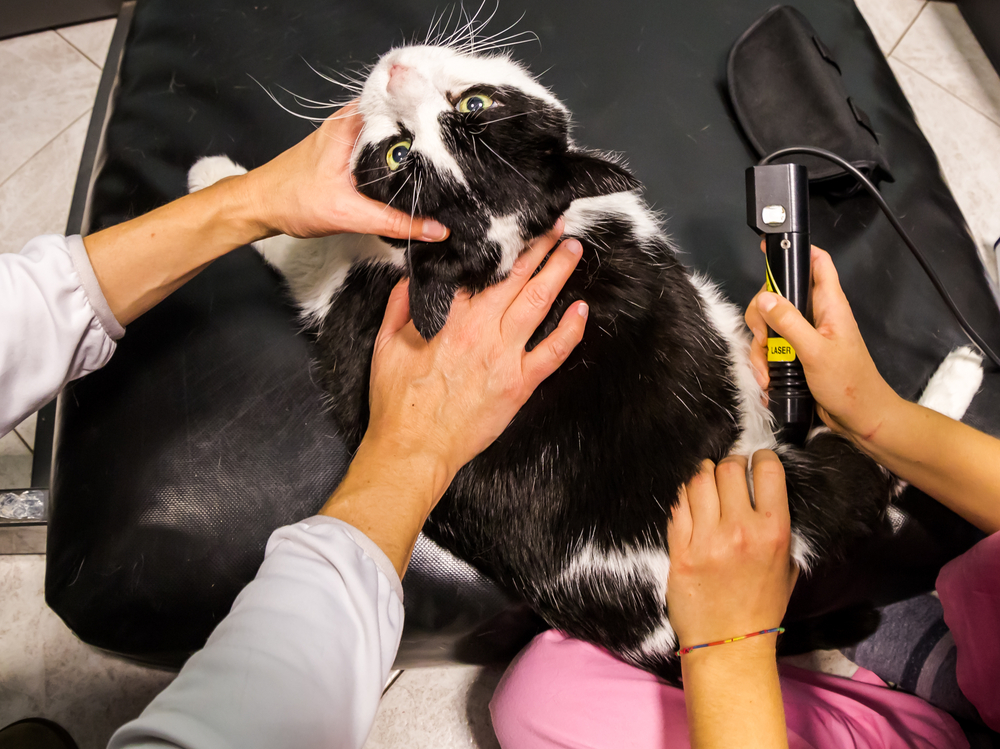Laser therapy is one of a growing number of alternative therapies available to pets that can decrease pain and stimulate healing, which makes it a viable treatment option for a wide variety of medical conditions. We can use laser therapy as a safe alternative to medication, or as a helpful adjunct to traditional treatments. With so many applications, you should find out whether your pet may be a laser therapy candidate.
What is laser therapy for pets?
Laser therapy is the application of a focused light beam to your pet’s body surface to stimulate beneficial health effects. Laser, an acronym for light amplification of stimulated emission of radiation, refers to a unit that generates a light beam that can be used in a variety of settings. Lasers are classified based on their wavelength and maximum energy output, and include:
- Class 1 — Class 1 lasers generate the lowest energy level, and are safely used for functions such as bar-code scanning.
- Class 2 — Class 2 lasers, which include laser pointers, emit light in the visible spectrum that will not cause eye damage, unless a beam is directed into the eye for prolonged periods.
- Class 3 — Class 3 lasers are most often used for veterinary laser therapy, also known as low-level laser therapy. The laser operator and the pet receiving treatment must wear eye protection to prevent accidental damage.
- Class 4 — Class 4 lasers, which are the most powerful, generate enough power to cut through tissue, so are used as surgical cutting lasers. The veterinarian must wear eye protection and take care to control the beam to avoid damaging nearby tissue.
How is laser light different from other light types?
Light emitted from a laser unit differs from other light types, such as sunlight, in that it is monochromatic, coherent, and collimated:
- Monochromatic — Light emitted from a laser unit consists of a single wavelength, unlike natural light, which contains differing wavelengths. A laser unit can be set to produce light at a particular wavelength to target absorption by specific tissues, and for specific effects.
- Coherent — The light photons generated by the laser unit all travel in the same phase and direction.
- Collimated — The light beam consists of parallel rays that do not diverge in other directions.
Coherence and collimation enable a laser beam to penetrate only a focused area so that nearby tissues are unaffected.
How does laser therapy benefit a pet’s health?
Cellular molecules, such as hemoglobin, proteins, and amino acids, absorb light photons emitted by laser units, become activated, and trigger physiologic activities. This mechanism, known as photobiomodulation, initiates processes directed toward tissue healing and repair. Mitochondria, for example, are stimulated to produce more adenosine triphosphate (ATP), a cellular energy source. Cellular functions are affected in additional ways, such as faster reactions, and recruitment of chemicals that act as secondary mediators to aid in the healing process.
The cellular processes initiated by laser therapy can lead to many beneficial effects for your pet, including:
- Reduced inflammation
- Reduced pain
- Reduced swelling
- Faster wound healing
- Muscle relaxation
- Endorphin release
- Vasodilation, which increases tissue blood flow to stimulate growth and healing
Which pets can benefit from laser therapy?
Veterinary laser therapy is most often used for wound healing, inflammation, and pain management, although its benefits may extend far beyond these applications. We often recommend laser therapy for pets with conditions such as:
- Joint pain
- Chronic arthritis
- Surgical incisions
- Skin wounds
- Tendon and ligament injuries
- Traumatic injuries
Laser therapy is often used as an alternative to traditional medications, or as part of a complementary treatment plan to conventional therapies. If performed correctly, using the proper settings and treatment durations, laser therapy is a safe option that can be particularly useful to pets whose medication use is restricted, such as:
- Pets with liver disease, who cannot metabolize some medications
- Cats for whom only a few pain-control medications are approved
- Exotic pets for whom medication administration is difficult, or impossible
- Older pets with diminished organ function
If you believe your pet could benefit from laser therapy, speak with our veterinary team about treatment options. Dr. Johnson has a special interest in laser therapy, is a certified veterinary pain practitioner (CVPP), and is the current president of the International Veterinary Academy of Pain Management (IVAPM). She travels and speaks nationally on veterinary pain management and laser therapy, and authored the chapter on pain management for Laser Therapy in Veterinary Medicine, published in 2017.
How is laser therapy administered to pets?

Laser therapy sessions typically last 15 to 30 minutes, during which the hand-held laser-unit wand is slowly moved back and forth over your pet’s damaged tissue. Treatments are not painful or uncomfortable; most pets experience a warm, pleasant sensation, and find treatment sessions relaxing. The frequency and number of sessions depend on your pet’s condition—chronic conditions may be treated once weekly, whereas surgical incisions and skin wounds often require daily treatment.
If you have questions about laser therapy, contact us to schedule an appointment to discuss the possible benefits for your pet.








Leave A Comment